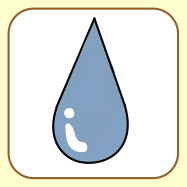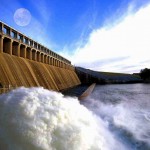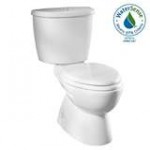 Conserving water is becoming increasingly important, and it has become a necessity in areas that are suffering from drought. According to the UN, by 2025, 1.8 billion people will be living in countries or regions with absolute water scarcity, and two-thirds of the world’s population could be living under water-stressed conditions, as a result of water shortages from climate change and rising levels of water use due to a growing population.
Conserving water is becoming increasingly important, and it has become a necessity in areas that are suffering from drought. According to the UN, by 2025, 1.8 billion people will be living in countries or regions with absolute water scarcity, and two-thirds of the world’s population could be living under water-stressed conditions, as a result of water shortages from climate change and rising levels of water use due to a growing population.
Reducing your water use will not only lower your water bills and help prevent potential water shortages. It also reduces the strain on municipal water systems and infrastructure (e.g., sewer, water treatment and distribution), which helps reduce the energy, maintenance, and the associated taxes required to run and expand those systems. Using less water can also save you money on your energy bill, because electricity or gas is used to heat your water. Water conservation also leaves more water available for critical uses, such as drinking, growing food, and fighting fires; and it keeps more water in lakes, rivers, and streams for aquatic species and other wildlife.
These are some of the ways that you can reduce your household water use, both indoors and outdoors:
INDOORS:
- Replace your toilets, faucets, and showerheads with high-efficiency (WaterSense labeled) plumbing fixtures, or at least add aerators to your faucets, and if you have an old toilet, put a small water bottle (filled with water, with the cap on) into the toilet tank for displacement. Switching to high-effiiency fixtures results in significant water savings.
- Do not let faucets run longer than is necessary for your task. Don’t leave it running while brushing your teeth, shaving, or soaping up your hands or dishes. And when you turn a faucet off, make sure that it is turned all the way off.
- Try to take short showers, and/or don’t take a shower every day (if you aren’t really dirty—from work, exercise, recreation, etc.).
- When using a clothes washer or dishwasher, only wash fairly full loads (or select a light-load setting for small loads). If you’re buying a new washer, select a high-efficiency (Energy Star) and water-saving model. Front-loading washing machines are much more efficient than top-loading machines.
- Wash dirty dishes immediately or soak them before hand-washing, so that they can be washed off more easily and quickly (requiring less water).
- If a faucet is dripping or if your toilet is running (for too long after it has been flushed), have the leak fixed right away. A leaking toilet can waste more than 50 gallons of water each day, and a dripping faucet or showerhead can waste up to 1,000 gallons of water per week (according to ResourceVenture.org). Also check for washing machine or dishwasher leaks (usually found where the hose is connected to the machine or at the shut-off valve). Familiarize yourself with the water shut-offs behind your toilet, sinks, and washing machine, as well as the water shut-off for the entire house, so that you know how to turn off the water when needed.
- As the saying goes, “If it’s yellow, let it mellow. If it’s brown, flush it down.” There’s generally no need to flush a toilet after it’s only been peed in one time. Hold off on flushing until the toilet has been peed in 2-3 times or has been used for “doing #2.”
- Compare your water bills (or water meter readings) from month to month and from year to year, to monitor the results of your conservation efforts and to look for any sudden spikes in water use, which could be caused by leaks.
OUTDOORS (yard / lawn / garden):
- Water your yard/garden during the coolest, least windy, and/or least sunny time of the day (usually overnight or early morning, ideally after midnight / before dawn) to avoid losing a lot of water via evaporation. And be sure to avoid over-watering; many plants do not need to be watered every day, and some rarely need to be watered at all.
- When you add new plants, trees, or other vegetation, select drought-tolerant or native/adapted plants that require little, if any, irrigation. To get information on how to choose the best plants for your area, click here.
- Putting mulch (including fallen leaves or wood chips) on your garden or landscaped areas can help the soil retain moisture longer.
- Turf grass typically requires much more water than groundcover or shrubs, so the less lawn area you have, the less watering you will need to do. If adding or reseeding grass areas, select a drought-tolerant, native grass variety or consider replacing the grass area with groundcover or native plants. As an added bonus, most types of groundcovers and some types of grasses will only grow a few inches tall, so they would rarely if ever need to be mowed.
- If you are installing an irrigation system, choose a high-efficiency irrigation system. Drip, micro, and bubbler irrigation systems are more efficient than spray or sprinkler irrigation, because they deliver water directly to plants’ roots, minimizing evaporative water loss. If you use a hose to water, use a shut-off/trigger nozzle on it so that the hose doesn’t continue to run when it isn’t aimed at the plants to be watered.
- If you have an irrigation system or sprinklers, make sure that all spray or drip spouts are oriented in such a way that they are watering planted areas only and are not watering the sides of buildings, pathways or other paved areas. In addition to wasting water, allowing water to pool up on pavement can make it slippery to walk on an can degrade the pavement over time.
- Also, for irrigation systems, perform (or have an irrigation specialist perform) regular system checks and maintenance, to make sure there are no leaking heads, pipes, or valves. Make sure the irrigation system is not watering the lawn/yard/garden during (or immediately preceding or following) rainy days. Even on dry days, make sure the system is not over-watering the plants or over-saturating the soil. If the irrigation timer runs on a battery, make sure it is working and change the battery as needed; if the battery is dead, the system could allow non-stop watering (which would waste a lot of water). Re-program the system seasonally and as necessary to adjust to weather conditions. Winterize the system before the first frost of each year. If issues arise, consider hiring an irrigation professional to do an irrigation audit.
- Consider adding rainwater collection barrels/tanks at downspouts (or a bucket in your shower or yard, or a greywater system) for use in watering your yard/garden.
- Sweep your sidewalks and driveway (and other paved areas), rather than hosing them down.
- Avoid washing your car frequently, and if/when you must wash it, take it to a carwash that recycles its water.
At a broader level, two of the most effective ways to reduce water use (indirectly but significantly) are: to reduce your energy use (because the generation of electricity typically requires enormous amounts of water), and to reduce or eliminate your consumption of meat (because raising meat animals, especially corn-fed factory-farmed beef cows, requires enormous amounts of water) as well as your consumption of milk and other dairy products (and also non-dairy soy milk, almond milk, and rice milk), which are also water-intensive to produce.
For more information on water conservation, visit these websites:

 According to the U.S. EPA, if all U.S. households installed water-efficient fixtures and appliances, the country would save more than 3 trillion gallons of water and more than $18 billion dollars per year.
According to the U.S. EPA, if all U.S. households installed water-efficient fixtures and appliances, the country would save more than 3 trillion gallons of water and more than $18 billion dollars per year. Toilets are often the source of the most water use (and water wasting) within a home, accounting for nearly 30 percent of an average home’s indoor water consumption. If you have a toilet(s) that uses more than 1.6 gallons of water per flush (gpf)—as do almost all toilets installed before 1994—replace it with one of the following:
Toilets are often the source of the most water use (and water wasting) within a home, accounting for nearly 30 percent of an average home’s indoor water consumption. If you have a toilet(s) that uses more than 1.6 gallons of water per flush (gpf)—as do almost all toilets installed before 1994—replace it with one of the following: